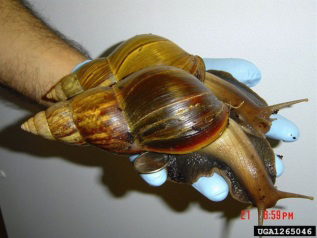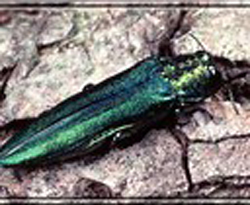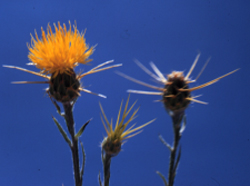 Invasive Plant Pest and Disease Awareness Month – Take Time to Be Aware
Invasive Plant Pest and Disease Awareness Month – Take Time to Be Aware
Cathi Boze, Mariposa County Agricultural Commissioner
April is Invasive Plant Pest and Disease Awareness Month, so this is the perfect time to consider how invasive species can crawl, swarm, or ooze their way into your daily life. The fact is that invasive pests and diseases hunger for many of the same things we enjoy each day. And as they feast on America’s agricultural and natural resources, they can devastate crops and forests, throw ecosystems out of balance and lead to lost jobs and closed export markets.
 So let’s follow a day in your life with these invasive species, starting right at the breakfast table. You savor your glass of orange juice at breakfast. Citrus greening disease spread by the Asian Citrus Psyllid also loves America’s citrus trees … to death, costing California and Florida’s citrus industry billions of dollars and thousands of jobs. You pour maple syrup over your pancakes. If Asian long horned beetles had their way, they’d be enjoying those maples, too … as they eat them from the inside out. This tree killer, now in Massachusetts, New York, and Ohio, threatens forest resources valued at billions of dollars.
So let’s follow a day in your life with these invasive species, starting right at the breakfast table. You savor your glass of orange juice at breakfast. Citrus greening disease spread by the Asian Citrus Psyllid also loves America’s citrus trees … to death, costing California and Florida’s citrus industry billions of dollars and thousands of jobs. You pour maple syrup over your pancakes. If Asian long horned beetles had their way, they’d be enjoying those maples, too … as they eat them from the inside out. This tree killer, now in Massachusetts, New York, and Ohio, threatens forest resources valued at billions of dollars.
 After breakfast, you might relish spending time in the garden or backyard. The giant African snail won’t want to leave your landscape because it can munch on 500 different types of plants and can even cause structural damage to plaster and stucco structures. This slimy pest, which can carry a parasite that can cause meningitis in people, was detected in Florida in 2011. USDA and the state are actively eradicating it and have collected and destroyed more than 115,000 snails.
After breakfast, you might relish spending time in the garden or backyard. The giant African snail won’t want to leave your landscape because it can munch on 500 different types of plants and can even cause structural damage to plaster and stucco structures. This slimy pest, which can carry a parasite that can cause meningitis in people, was detected in Florida in 2011. USDA and the state are actively eradicating it and have collected and destroyed more than 115,000 snails.
Invasive pests and diseases prefer many of your lunchtime favorites. Exotic fruit fly maggots can’t resist apples, pears, and dozens of other fruits and vegetables. In Florida, Texas, and California, USDA and its partners have eradicated numerous exotic fruit fly outbreaks over the last several decades before they could wreak havoc on crops.

The afternoon is a great time for a baseball game. But the sound of an ash bat smacking a ball into the stands could be silenced. The emerald ash borer beetle, detected in 24 states, has destroyed tens of millions of ash trees so far.
At dinner, you might like to relax with a fine California wine. Another grape connoisseur is the European grapevine moth. This little pest, almost eradicated in California, could threaten $8.7 billion in U.S. fruit crops.
 Non-native plants, animals, and pathogens can harm humans and the environment and impact our nation's economy. The damage done by invasive plants alone costs the U.S. an estimated $34.7 billion a year. People are the biggest influence when it comes to introducing and spreading hungry pests, but people are also the solution. There are things that each of us can do to help stop the spread. It's up to each of us to be sure that we're not packing a pest when we move things outdoors, go camping, or travel internationally. These damaging pests can hitchhike from place to place on our cars and trucks, hidden in fruit, vegetables, plants, firewood or on familiar outdoor items. But we can all learn to be more careful when we're traveling or involved in outdoor activities. Working together, we can protect our crops and trees from harm. It all begins with awareness.
Non-native plants, animals, and pathogens can harm humans and the environment and impact our nation's economy. The damage done by invasive plants alone costs the U.S. an estimated $34.7 billion a year. People are the biggest influence when it comes to introducing and spreading hungry pests, but people are also the solution. There are things that each of us can do to help stop the spread. It's up to each of us to be sure that we're not packing a pest when we move things outdoors, go camping, or travel internationally. These damaging pests can hitchhike from place to place on our cars and trucks, hidden in fruit, vegetables, plants, firewood or on familiar outdoor items. But we can all learn to be more careful when we're traveling or involved in outdoor activities. Working together, we can protect our crops and trees from harm. It all begins with awareness.
 Invasive species are plants, animals, and microorganisms that are not native to a particular area. They are also species that are capable of causing severe damage in areas outside their normal range, harming the economy, the environment, or human health once they become established. The term "invasive" is reserved for the most aggressive nonnative species capable of changing site or living conditions for the worse where they establish.
Invasive species are plants, animals, and microorganisms that are not native to a particular area. They are also species that are capable of causing severe damage in areas outside their normal range, harming the economy, the environment, or human health once they become established. The term "invasive" is reserved for the most aggressive nonnative species capable of changing site or living conditions for the worse where they establish.
Invasive species are found in water and on land. In fact, invasive species can occur in just about every habitat type you can imagine: lakes and streams, cities, fields and farms, and all of the native areas of the state. A few of the common species found on land include weed species such as yellow star thistle, Klamath weed, and knapweeds, and pathogens that cause Sudden Oak Death, Dutch elm disease, and oak wilt. Others that folks are becoming aware of are the Asian Citrus Psyllid, the emerald ash borer, the Gold Spotted Oak borer, and the Red Imported Fire Ant as well as Zebra and Quagga mussels in our waterways.
 Every species evolves in its home territory to have one to several ways to expand its range. They may be wind-blown, rain splashed, carried by animals, or moved in soil or water. Almost all short-distance spread is through these natural dispersal mechanisms. In their home territory, short distance spread is rarely a problem because the resident plants and animals have evolved to coexist more or less peaceably.
Every species evolves in its home territory to have one to several ways to expand its range. They may be wind-blown, rain splashed, carried by animals, or moved in soil or water. Almost all short-distance spread is through these natural dispersal mechanisms. In their home territory, short distance spread is rarely a problem because the resident plants and animals have evolved to coexist more or less peaceably.
On the flip side, long distance spread is almost always human assisted. Because long distance spread takes the species a long way from home, the resident plants and animals are not often prepared to cope with their new neighbor. Natural enemies are missing and host species often lack the natural defenses necessary to survive an attack by the introduced species. Once introduced, aggressive species are free to expand their range using their short distance dispersal mechanisms with a competitive advantage over native plant and animals due to the lack of natural enemies.
Preventing the introduction and establishment of invasive species in a new area is everyone's responsibility. And there are important, simple things that we should all be aware of:
- Invasive pests can easily be transported on living plants or fresh products such as fruit.
- A number of insect and disease pests of trees can move in cut firewood, lumber, pallets, or solid wood packing material.
- Buy Local, Burn Local: A good rule of thumb is “Don't move firewood” - instead, buy it where you'll burn it, or gather on site when permitted. Learn more at: DontMoveFirewood.org.
- Keep It Clean: Clean hiking boots, waders, boats and trailers, off-road vehicles, tires, and other gear between fishing, hunting or camping tripsto stop invasive species from hitching a ride to a new location. Learn more at: PlayCleanGo.org.
- Invasive species have many pathways of spread. For instance, weed seeds move easily in soil so, muddy boots or vehicles can move weed seeds. Some weeds seeds have special hooks to help them hitch a ride (in this case, the “Velcro” plant or bur chervil). Thus, weeds seeds can spread on our shoes, socks, clothing, and pets.
- Plant Carefully: Buy only certified, pest-free nursery whenever possible. Buy your plants from a reputable source, avoid using invasive plant species, and remove any known plant invaders.
- Some invasive plants are quite attractive, so they can show up in nurseries as ornamental plants. They can also hide in nursery stock, potting mixes, or home décor made from raw wood products. Not all non-native species are bad, but some plants that look lovely in your garden might be harmful invaders that will make their way into natural areas. The Be PlantWise website (www.beplantwise.org) has easy tips on how to manage your garden to preserve the unique qualities of neighboring wild lands.
- Use forage, hay, mulch, and soil that are certified as "weed free."
- Ask your political representatives at the state, local and national level to support invasive species control efforts.
- Being aware of these pathways of spread can help us reduce the risk of accidentally moving harmful invasive species. By learning how to inspect and clean our belongings and knowing the source of the things we buy, we can begin to reduce the chance of inadvertently spreading something that could harm those things we cherish.
- Learn To Identify: If you see signs of an invasive pest or disease, write down or take a picture of what you see, and then report it to the Mariposa County Department of Agriculture at: (209) 966-2075.








